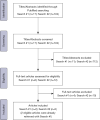Procedural simulators for teaching and learning vasectomy techniques: a scoping review
- PMID: 39280682
- PMCID: PMC11399053
- DOI: 10.21037/tau-24-113
Procedural simulators for teaching and learning vasectomy techniques: a scoping review
Abstract
Background: Procedural simulators can facilitate teaching and improve learning vasectomy surgical techniques. The objectives of this scoping review were to identify available vasectomy simulators (scrotal models), and to assess their characteristics and potential suitability for optimal transfer of surgical skills of most recommended techniques in clinical practice.
Methods: We performed searches up to December 2023 using PubMed and Google search engines to identify existing vasectomy simulators. Articles and Web pages reporting vasectomy simulators were also examined using a snowball strategy. In addition, we asked members of the Vasectomy Network, an international Google discussion group, if they knew any other simulators. Two members of the research team performed the initial evaluations of the physical and functional characteristics of retrieved simulators. All team members made consensus on final evaluations.
Results: We retrieved 10 relevant scrotal models through PubMed (n=2), Google (n=4), and the Vasectomy Network (n=4). Three were commercially available simulators produced by Gaumard® in the USA and seven were homemade models. All had limited visual and haptic realism of internal and external structures. Most, however, were suitable for simulating some basic skills of the no-scalpel technique to deliver the vas deferens. Fascial interposition could not be simulated with any model. Commercially available models had no advantage over homemade models.
Conclusions: Most vasectomy simulators currently available allow learning some basic surgical skills of the procedure but have limitations for optimal learning of the recommended techniques and skill transfer in clinical practice. There appears to be a need to develop and evaluate new simulators with enhance visual and haptic characteristics for teaching and learning vasectomy techniques.
Keywords: Vasectomy; competency-based education; high-fidelity simulation training; scoping review; surgical models.
2024 Translational Andrology and Urology. All rights reserved.
Conflict of interest statement
Conflicts of Interest: All authors have completed the ICMJE uniform disclosure form (available at https://tau.amegroups.com/article/view/10.21037/tau-24-113/coif). C.D., M.L., and B.P. report grant from the Support Program for Educational Innovation in Health Sciences of the Gilles-Cormier Fund of the Faculty of Medicine of Université Laval (INNOV_FGC2020), which was used to conduct this review and the initial research and development activities to create a new vasectomy simulator taking into account the findings of this review. M.L. is a member of the AUA vasectomy guideline committee (unpaid). The other author has no conflicts of interest to declare.
Figures


References
-
- Wagner KE, Soyster ME, Bartels C, et al. Improving resident learning on vasectomy: a national survey on urology resident vasectomy training. Can J Urol 2021;28:10941-5. - PubMed
-
- Hoogenes J, Matsumoto ED. Chapter 10: Simulation Surgical Models: Surgeon Perspectives. In: Farhat WA, Drake J. editors. Bioengineering for Surgery. Sawston, Cambridge, UK: Chandos Publishing; 2016:167-88.
Publication types
LinkOut - more resources
Full Text Sources
